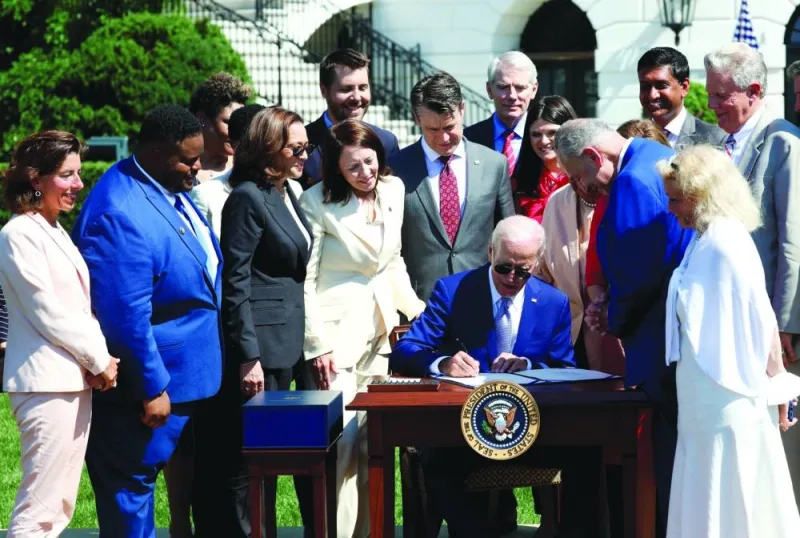Industrial policy has always been a controversial dimension of growth and development strategies in emerging economies. Now, the introduction of the CHIPS and Science Act and the (misnamed) Inflation Reduction Act in the US has reignited a similar debate in advanced economies. Unfortunately, it’s a debate that often generates more heat than light.
The objective of industrial policies is to alter market outcomes in ways that align them better with a country’s broader economic and social objectives. Free-market purists may bristle, but in the real world many relatively uncontroversial – and even widely supported – government interventions shape market outcomes.
For example, public-sector investment in infrastructure, education, and the economy’s science and technology base is considered an essential complement to private investment, mitigating risks, increasing returns, and bolstering overall economic performance. Other widely accepted interventions that alter market outcomes include antitrust or competition policy, measures to overcome information gaps and asymmetries, and regulation to address negative externalities, protect user data, and guarantee the safety of everything from airplanes to food.
But these are responses to known market failures. Industrial policies – at least the most divisive ones – go a step further, reshaping the supply side of the economy in pursuit of objectives other than efficiency in the allocation of resources.
The CHIPS and Science Act offers an interesting case study. The legislation, passed last year, has three main components. The first is investment in science and technology and the associated human capital. While a key goal may be to ensure that the US retains the upper hand in its strategic competition with China, such investment does not directly alter the market-determined structure of the domestic or global economy.
By contrast, the second component – shifting numerous links in complex global semiconductor supply chains either to the US or to friendly or reliable trading partners – directly overrides market outcomes in a crucial sector. It does this for the sake not of improving efficiency, but to bolster national security and economic resilience.
The third main component – restrictions on trade, investment, and technology flows to China – will have a similarly far-reaching impact on America’s trading partners and the structure of the global economy. Again, efficiency is not the goal. Rather, the US hopes to impede China’s progress in advanced technologies, including semiconductors and artificial intelligence.
The first component is not particularly contentious. Nor is the third, at least domestically, despite its long-term consequences for America’s economic relationships and the coherence of the multilateral trading system. Antipathy toward China, after all, is one of very few areas of bipartisan agreement in the US.
The second component, however, has proved divisive. Critics point out that selective public investment in any industry’s productive capacity amounts to picking winners and losers. In their view, governments are not well-equipped to take on this task, not least because vested interests can capture the decision-making process.
Though this argument in favour of relying on market outcomes should not be dismissed out of hand, it should be met with some scepticism, not least because it is often rooted in an almost religious commitment to unfettered competition. In fact, industrial policy can be essential to a country’s long-term economic survival, as in the case of defence, particularly in times of war.
The real question is not whether industrial policy is worth pursuing, but how to do it well. Government capacity is decisive: to act effectively as an investor and major buyer of products and services, the government needs people with talent and experience – receiving compensation to match – and well-designed institutions. Moreover, goals should be precise, limited, and clear, and guardrails must be erected to protect against private-sector capture. Industrial policy is not corporate welfare.
Examples of successful industrial policy abound. The Defense Advanced Research Projects Agency, for example, has an impressive track record in driving technological development for the US military through partnerships with universities and private-sector players, with massive positive spillovers to the broader economy.
The US system for allocating funds for basic research in science and engineering also works well: it definitely picks winners and losers, but in a reasonably objective way, thanks to a combination of expert peer assessment and genuine competition. The stunning success of the Covid-19 vaccine-development program offers many lessons for designing effective interventions.
To be sure, there are also plenty of examples of failed industrial policies. But only some of these failures can be traced to design flaws. Investments aimed at altering market outcomes and influencing technological development are inherently risky; their outcomes can never be guaranteed. No one expects every investment made by a venture-capital fund to be a home run. Governments should be afforded the same leeway. A decent track record is good enough to make industrial policy pay off for taxpayers.
At a time of rising geopolitical tensions and supply-chain fragmentation – when national-security considerations are shaping economic policy, and the risks of war seem to be growing – industrial policy is all but inevitable. We should be learning from past experience, identifying the risks each approach raises, recruiting the best talent, and setting sensible standards for evaluating performance – not getting mired in superficial, ideologically-charged discussions that fail to account for the range of possible interventions, and the fact that not all objectives align well with economic efficiency. – Project Syndicate
l Michael Spence, a Nobel laureate in economics, is Emeritus Professor of Economics and a former dean of the Graduate School of Business at Stanford University.

(File photo) US President Joe Biden signing the CHIPS and Science Act of 2022 on August 9.


